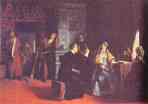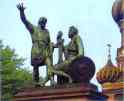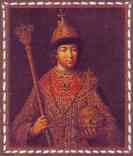Olga's Gallery
Dear Friends of Art,
During the first two weeks of October we have added the collections of Pieter de Hooch, Adriaen van Ostade and his younger brother Isaack van Ostade.
Today we continue the story about the Time of Trouble in Russia (1598-1613) as seen by the Dutch merchant Isaak Massa.
The Time of Trouble
Part II
 After
False Dmitry I was killed, the throne did not remain empty for long, the
Boyars “elected Vasily Shuisky to be their tsar,” and demanded that he
forfeit some of the tsar’s rights. “The old tsarina, whom False Dmitry
had called his mother, was allowed to live in Moscow, though she was scolded
much for having lied that the imposter was her son, but she claimed that
she did it because she was afraid for her life….” The Polish nobles who
survived the riot, including the young widow of False Dmitry, Marina Mnishek,
“were exiled to Yaroslavl on the Volga, and there they lived under arrest.”
After
False Dmitry I was killed, the throne did not remain empty for long, the
Boyars “elected Vasily Shuisky to be their tsar,” and demanded that he
forfeit some of the tsar’s rights. “The old tsarina, whom False Dmitry
had called his mother, was allowed to live in Moscow, though she was scolded
much for having lied that the imposter was her son, but she claimed that
she did it because she was afraid for her life….” The Polish nobles who
survived the riot, including the young widow of False Dmitry, Marina Mnishek,
“were exiled to Yaroslavl on the Volga, and there they lived under arrest.”
Shuisky had been a tsar hardly any time, when another False Dmitry appeared on the Polish border, claiming that he had managed to escape the Moscovite intrigue. The identity of this new adventurer remains a historical mystery. In Moscow itself “there were two parties; one believed that Dmitry was still alive, having escaped two or three days before the revolt and leaving someone else to die in his stead; the other said that he was dead… And I agree with the latter because I saw him alive and I examined his dead body after he was killed, and I am sure that it was the genuine article.”
“Everyday there came reports that a big army was approaching Moscow and that the Moscovites are losing battles, one after another…” “… at last on the 2nd of June, the enemy came to Moscow, with tsar Dmitry, as he was called, bringing many nobles from Lithuania and Poland: the Vishnevetskys, the Tyshkevichs and all the relatives of Sandomirsky, and the great Chansellor Leo Sapega; their army surrounded Moscow, and occupied all the convents and villages…” “Pskov was also ruined and burned, and all the land around was robbed and deserted, and many rich people were killed; the same happened to Ivangorod, called the Russian Narva…”
Facing such a difficult situation, foreign merchants fled from Moscow to Archangelsk and escaped the country by ship. “When we departed to our fatherland by sea, we left the country full of war and misery, and Moscow was under siege…” “In short, the war here can last for a long time yet.” Massa ends his story here. We’ll go on and describe the next 5 years full of both tragic and heroic proceedings.
The events that followed almost repeated the case of False Dmitry I. False Dmitry II was supported by part of the nobles and Cossacks. They failed to seize Moscow, and settled in Tushino, a town not far from Moscow, robbing the surrounding countryside. Marina Mnishek came to Tushino and “recognized” her husband. The war went on until 1608 when Shuisky at last managed to suppress False Dmitry II. By that time Marina had given birth to a son, Ivan. In 1613, he was among the candidates when the boyars were electing a new tsar. The destiny of the child was awful, he was killed immediately after the first tsar of the Romanov dynasty was proclaimed.
Moscow and the tsar Vasily Shuisky didn’t have time to celebrate their victory over False Dmitry II, the Polish king Sigismund II Augustus (1520-72), started a war against Russia in September 1609. Thr Boyars overthrew Shuisky and signed an agreement with Sigismund II about the transfer of the throne to his son, Vladislaw. Poles occupied Moscow, but the other cities of Russia rebelled, they started to gather militia. Sweden used the situation to capture northern Russia, including Novgorod, the citizens of which had to agree to have Swedish prince Karl-Philip as their tsar. Another False Dmitry appeared in Pskov. The country was in chaos.
 The
city of Nizhniy Novgorod became the center of the liberation movement of
the country. It was an economical and industrial center on the Volga. In
autumn the local community elected the merchant Kuzma Minin as their head.
The new head called upon his compatriots to save Russia and help it to
remain a single state. He was the first to contribute a big sum of money
to the militia. He understood well enough that only a coalition of all
the Russian cities could save the country, and sent out his proclamation
of union. The meaning of this call-to-arms should not be underestimated.
The long period of unrest had a psychological effect: the people did not
care much who became the tsar, or what happened to Russia, they wanted
only peace and rest, so it was not easy to awaken the patriotism of the
people. Nizhniy Novgorod started to gather an army. They chose prince Dmitry
Pozharsky as the commander because he was highly esteemed by the people:
he was a known military leader and had no connections with court intrigues.
The
city of Nizhniy Novgorod became the center of the liberation movement of
the country. It was an economical and industrial center on the Volga. In
autumn the local community elected the merchant Kuzma Minin as their head.
The new head called upon his compatriots to save Russia and help it to
remain a single state. He was the first to contribute a big sum of money
to the militia. He understood well enough that only a coalition of all
the Russian cities could save the country, and sent out his proclamation
of union. The meaning of this call-to-arms should not be underestimated.
The long period of unrest had a psychological effect: the people did not
care much who became the tsar, or what happened to Russia, they wanted
only peace and rest, so it was not easy to awaken the patriotism of the
people. Nizhniy Novgorod started to gather an army. They chose prince Dmitry
Pozharsky as the commander because he was highly esteemed by the people:
he was a known military leader and had no connections with court intrigues.
The cooperation of Minin and Pozharsky, was the foundation for victory. Together they liberated Moscow and other occupied Russian cities, created a provisional government and prepared the election of a new tsar.
 In
the beginning of 1613, Zemskoy Sobor (a meeting of electors from the nobles,
town citizens, Cossacks, free peasants and other classes of population,
except serfs) gathered in Moscow. On February 21, 1613, the 16-year old
Mikhail Fedorovich Romanov was elected the tsar of all Russia. His descendants
were to rule Russia for the next 300 years.
In
the beginning of 1613, Zemskoy Sobor (a meeting of electors from the nobles,
town citizens, Cossacks, free peasants and other classes of population,
except serfs) gathered in Moscow. On February 21, 1613, the 16-year old
Mikhail Fedorovich Romanov was elected the tsar of all Russia. His descendants
were to rule Russia for the next 300 years.